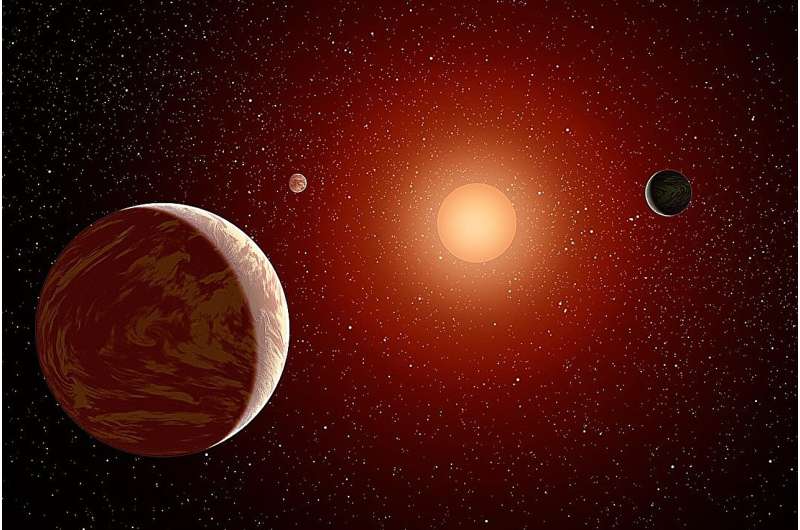
October 11, 2024 by Matt Williams, Universe Today
Collected at: https://phys.org/news/2024-10-exoplanet-binary-red-dwarfs-massive.html
In recent years, the number of known extrasolar planets (aka. exoplanets) has grown exponentially. To date, 5,799 exoplanets have been confirmed in 4,310 star systems, with thousands more candidates awaiting confirmation. What has been particularly interesting to astronomers is how M-type (red dwarf) stars appear to be very good at forming rocky planets.
In particular, astronomers have detected many gas giants and planets that are several times the mass of Earth (Super-Earths) orbiting these low-mass, cooler stars.
Consider TOI-6383A, a cool dwarf star less than half the mass of the sun that orbits with an even smaller, cooler companion—the red dwarf star TOI-6383B. In a recent study, an international team of astronomers with the Searching for Giant Exoplanets around M-dwarf Stars (GEMS) survey detected a giant planet transiting in front of the primary star, designated TOI-6383Ab.
This planet is similar in size and mass to the system’s companion star, which raises questions about the formation of giant planets in red dwarf star systems.
The team was led by Lia Marta Bernabò, a Ph.D. astronomy student at the University of Texas at Austin (UTA) and the German Aerospace Center (DLR).
She was joined by colleagues with the GEMS collaboration, which includes astronomers from the Center for Planetary Systems Habitability, the Carnegie Science Earth and Planets Laboratory, the Center for Exoplanets and Habitable Worlds, the ETH Zurich Institute for Particle Physics & Astrophysics, the Anton Pannekoek Institute for Astronomy, NOIRLab, the NASA Goddard Space Flight Center, and multiple universities and institutes.
The paper that details their findings was recently accepted for publication by the Astronomical Journal. It is published on the arXiv preprint server.

The TOI6383 system consists of two red dwarf stars located about 560 light-years from Earth. The primary (A) is about 46% as massive as the sun and about as large and has an estimated surface temperature of 3,444 K (3,170 °C; 5,740 °F)—about 60% of the sun’s surface temperature.
Its companion (B) is 20.5% as massive as our sun, 22% its size, and has an estimated surface temperature of 3,121 K (2,848 °C; 5,158 °F). Meanwhile, TOI6383Ab has a mass and size comparable to Jupiter and an orbital period of about 1.79 days.
Based on the all-sky coverage of NASA’s Transiting Exoplanet Survey Satellite (TESS), the GEMS survey team is dedicated to searching for giant exoplanets around M-dwarf stars (GEMS) using the Transit Method (Transit Photometry). This consists of monitoring stars for periodic dips in brightness, which could indicate planets passing (aka transiting) in front of their parent stars relative to the observer.
The exoplanet was detected by TESS and confirmed by a combination of follow-photometry and radial velocity measurements using ground-based telescopes.
This survey aims to test theories of how planets form, which can be divided into two main categories. The first scenario is the core-accretion model, where planetesimals coagulate around a massive core.
However, this model has come to be questioned in recent decades, largely because it is inconsistent with the mass budget and time scales for the formation of M dwarfs. Dwarf stars typically have less massive protoplanetary disks around them, meaning there is insufficient material to form giant planets.
The second scenario is the rapid formation model, where a massive protostellar disk disintegrates into clumps under its own gravity, which then accrete material and form planets. The discovery of this latest massive planet around a low-mass star will help astronomers to test these competing models.
To date, only 20 massive exoplanets have been detected around M-type red dwarfs. The GEMS survey seeks to increase this inventory to at least 40, whereupon more precise tests of these models can be made.
More information: Lia Marta Bernabò et al, Searching for GEMS: TOI-6383Ab, a giant planet transiting an M3-dwarf star in a binary system, arXiv (2024). DOI: 10.48550/arxiv.2409.16889
Journal information: Astronomical Journal , arXiv

Leave a Reply